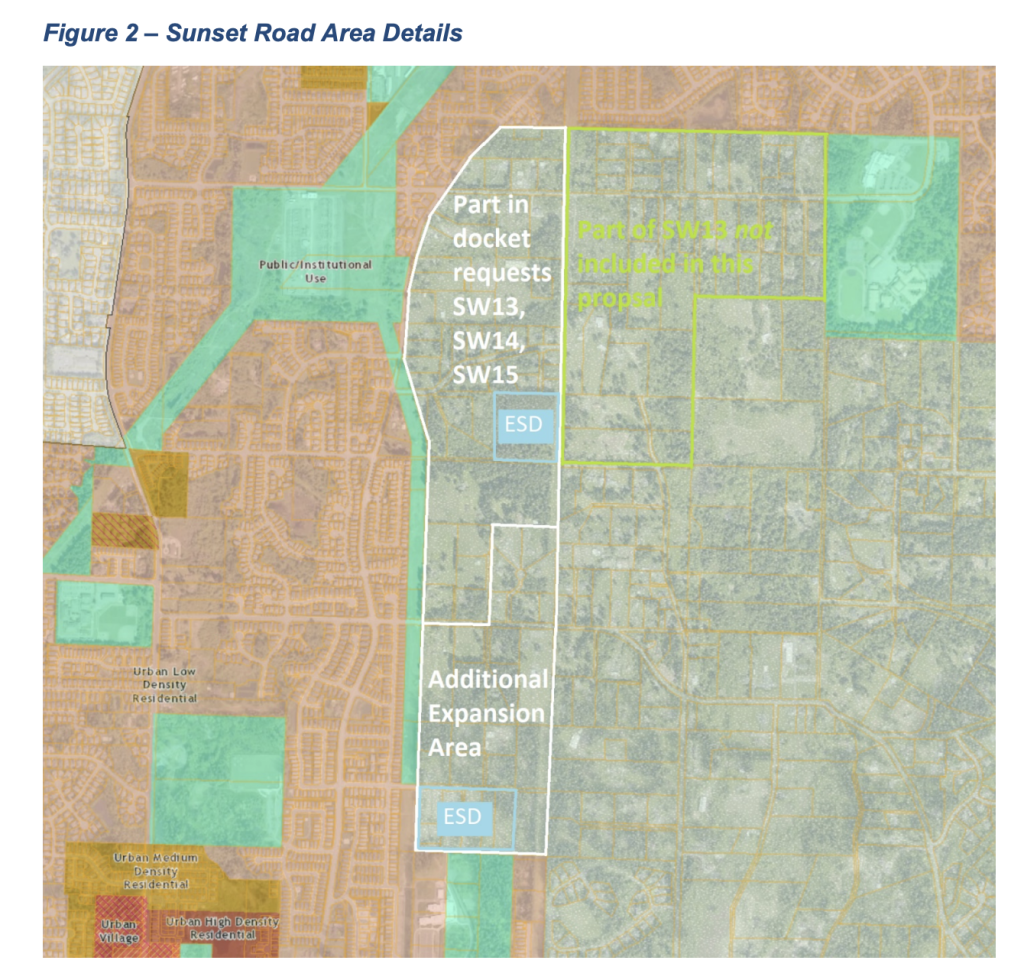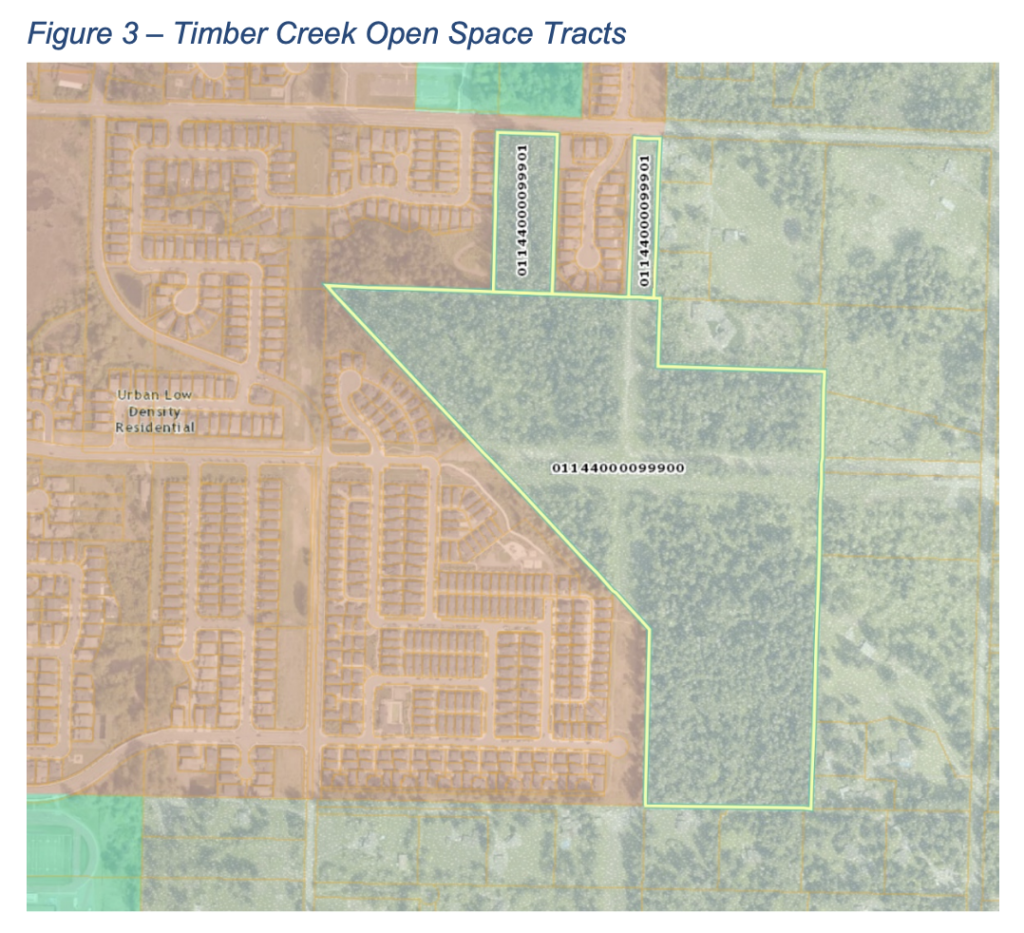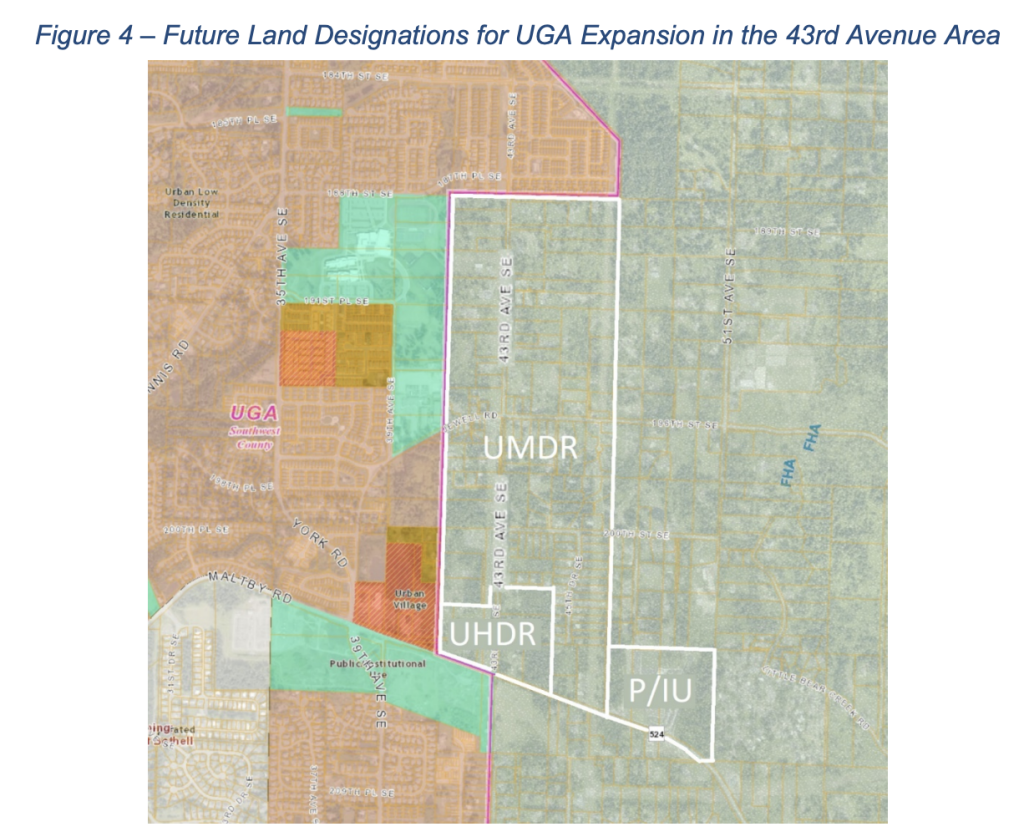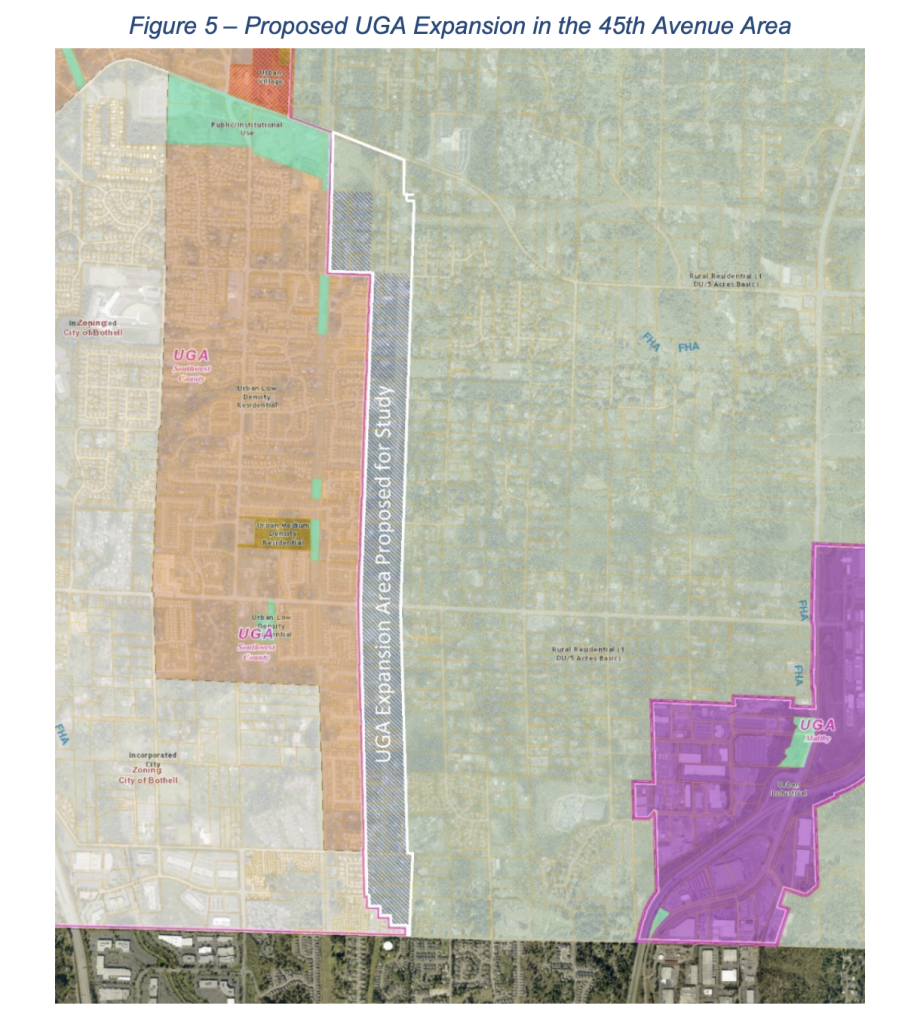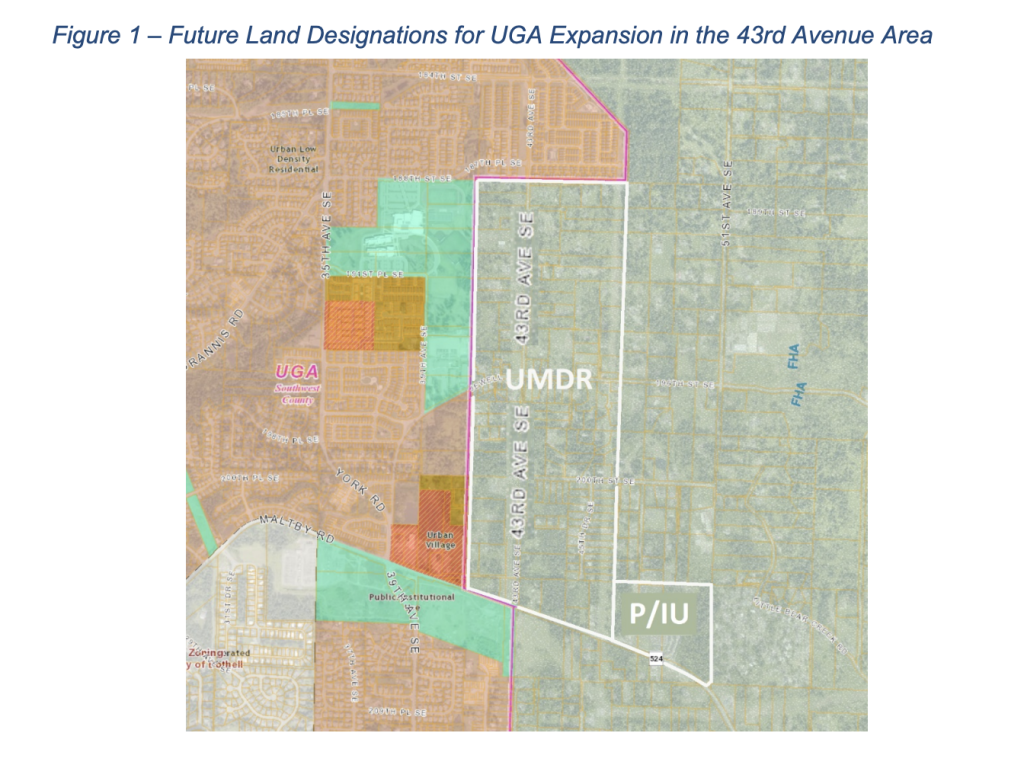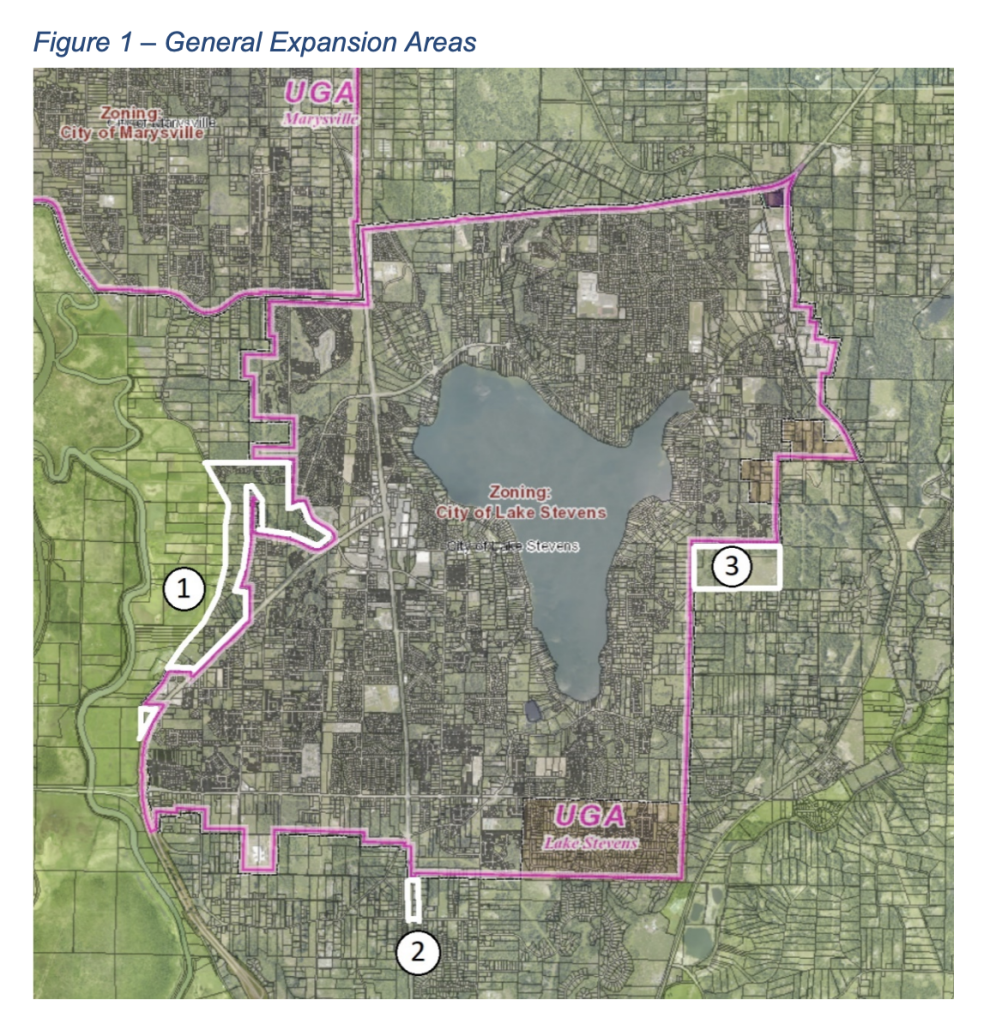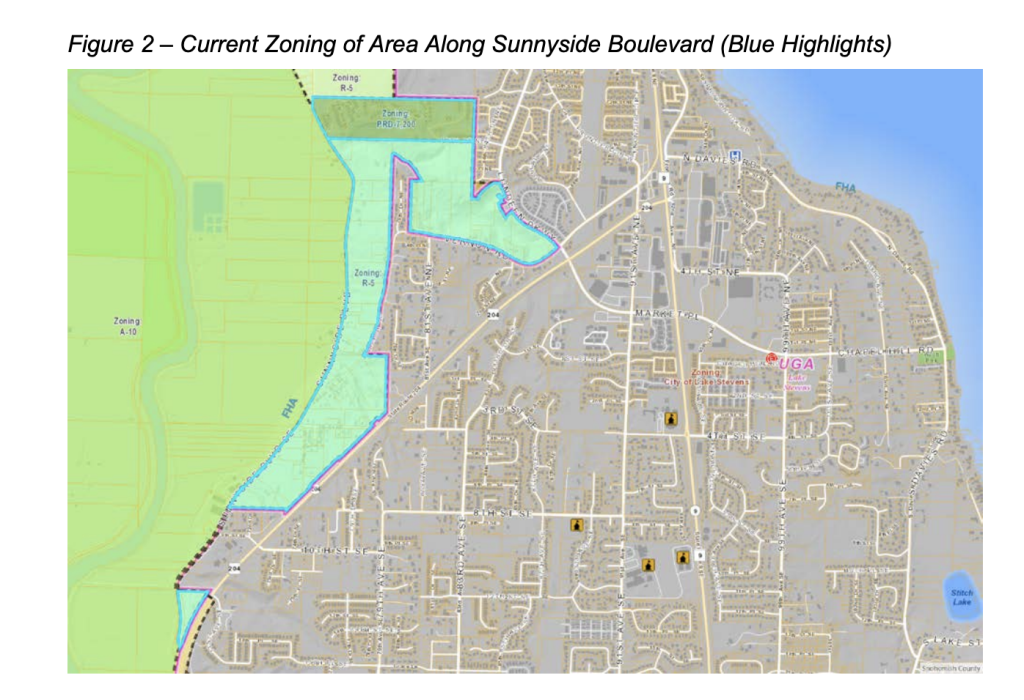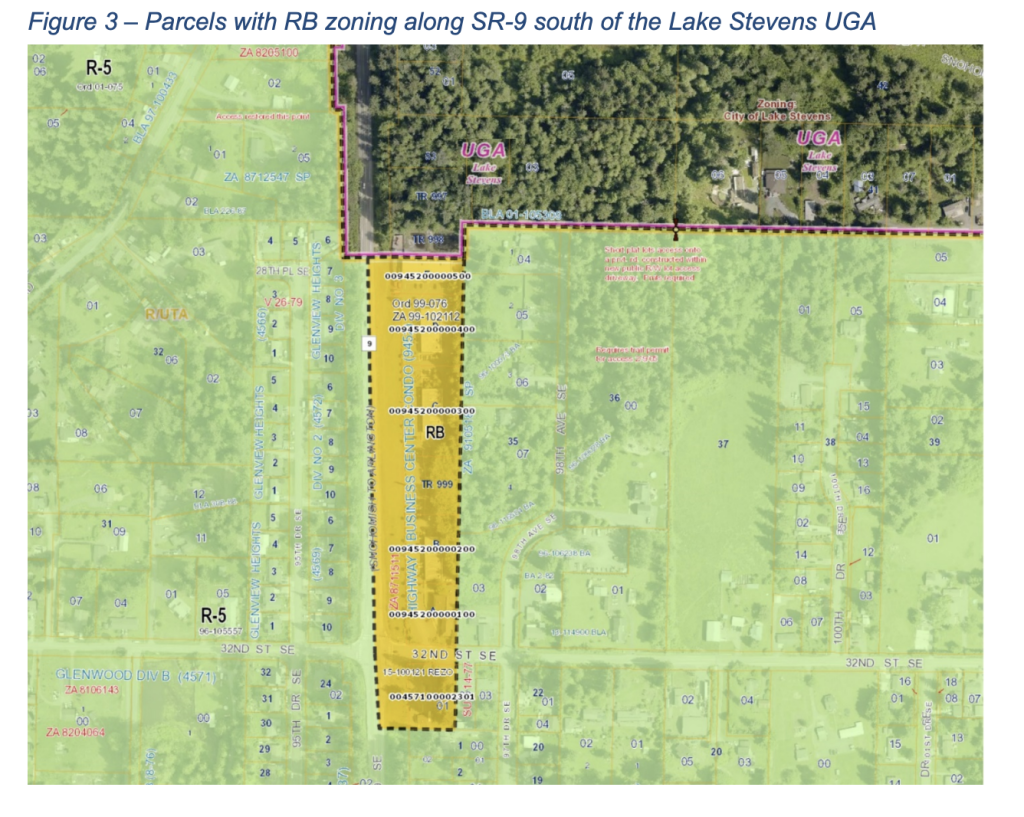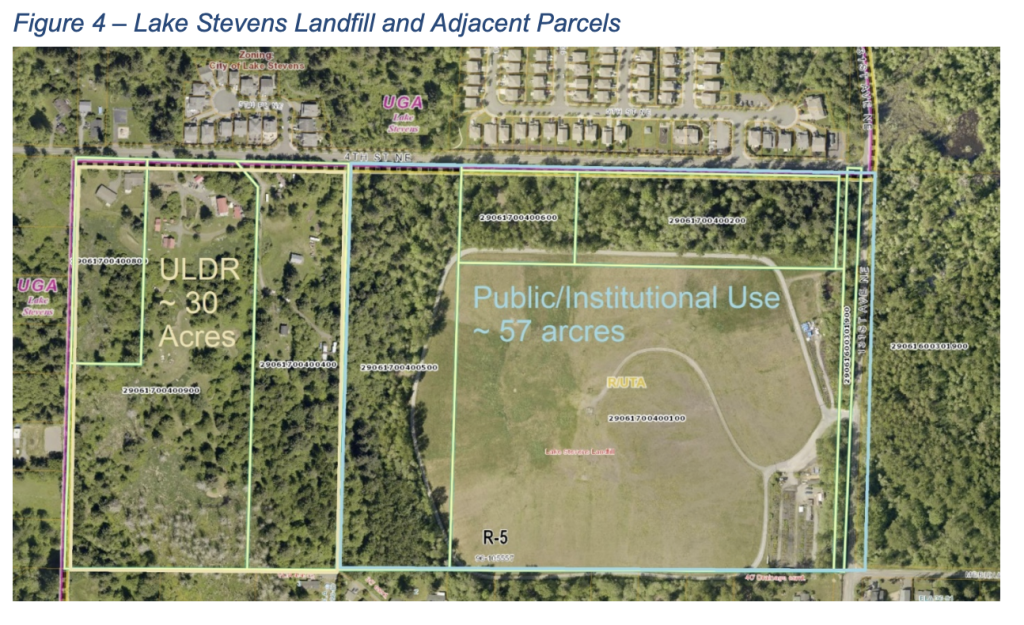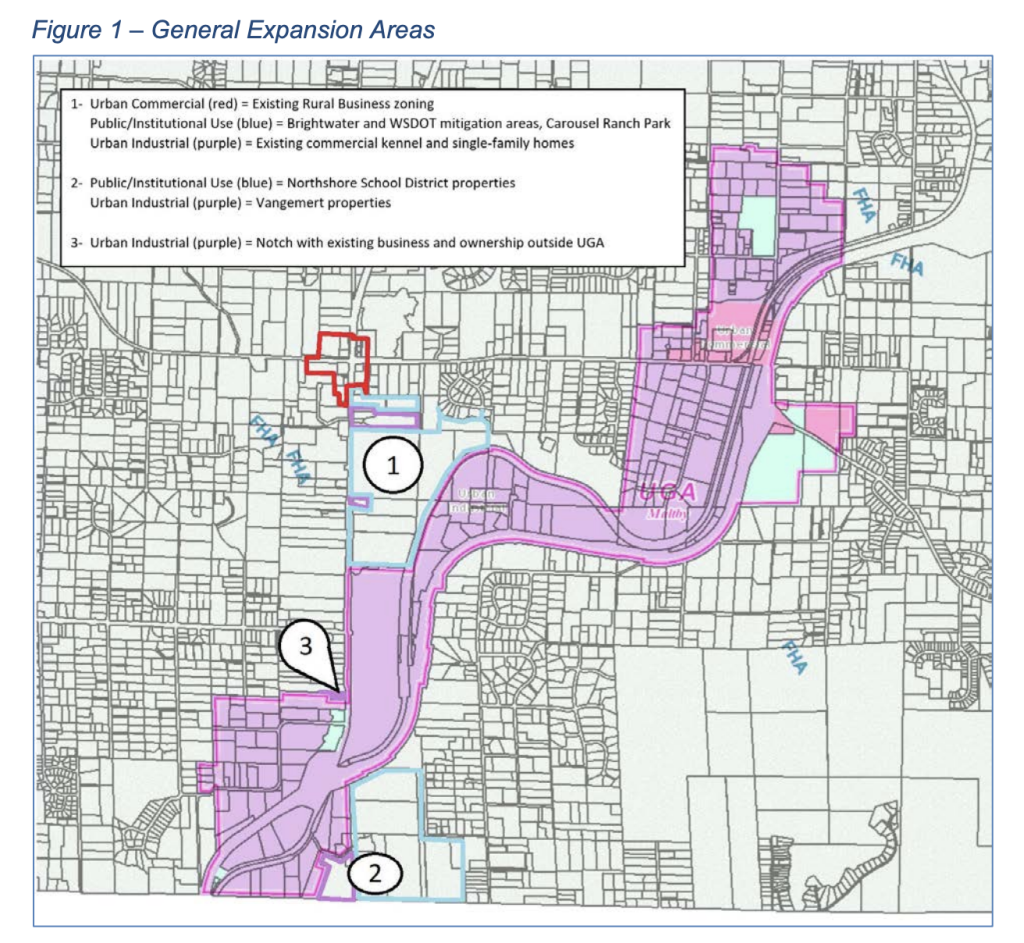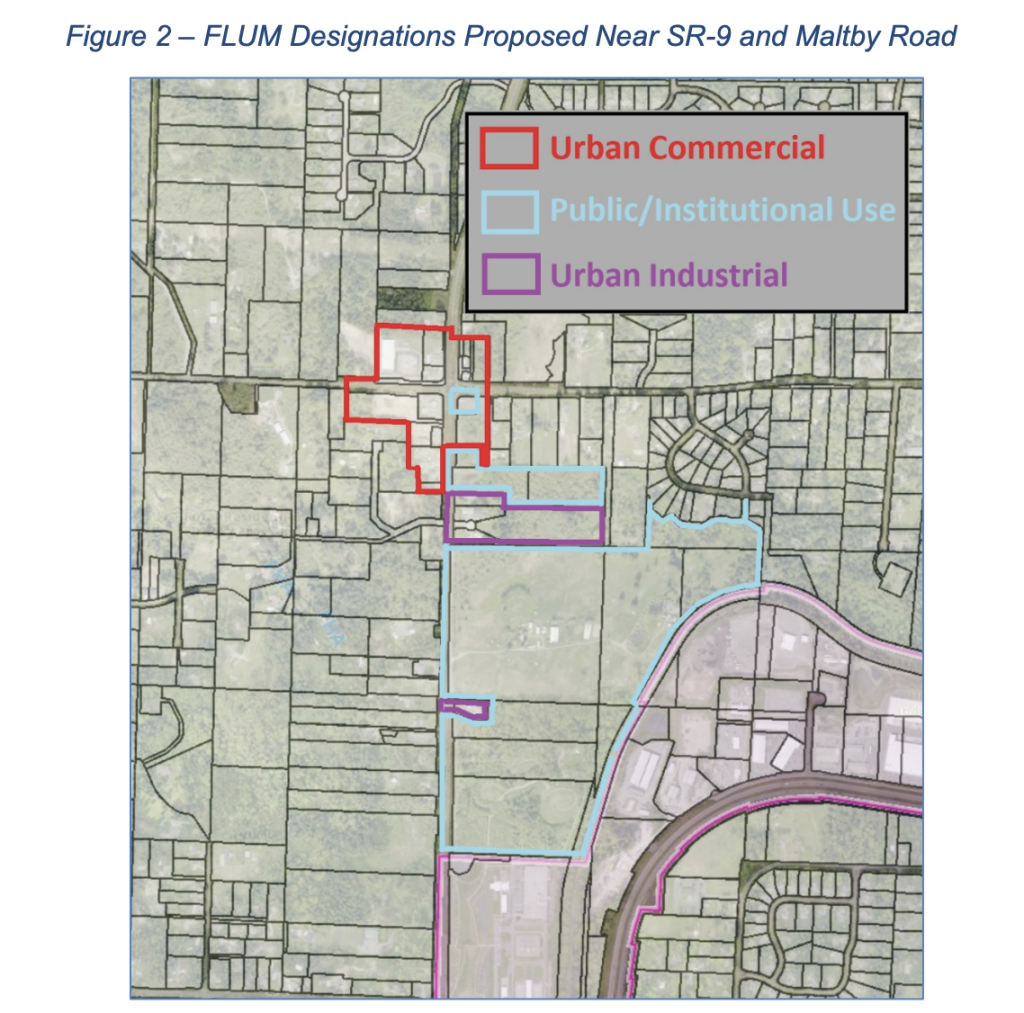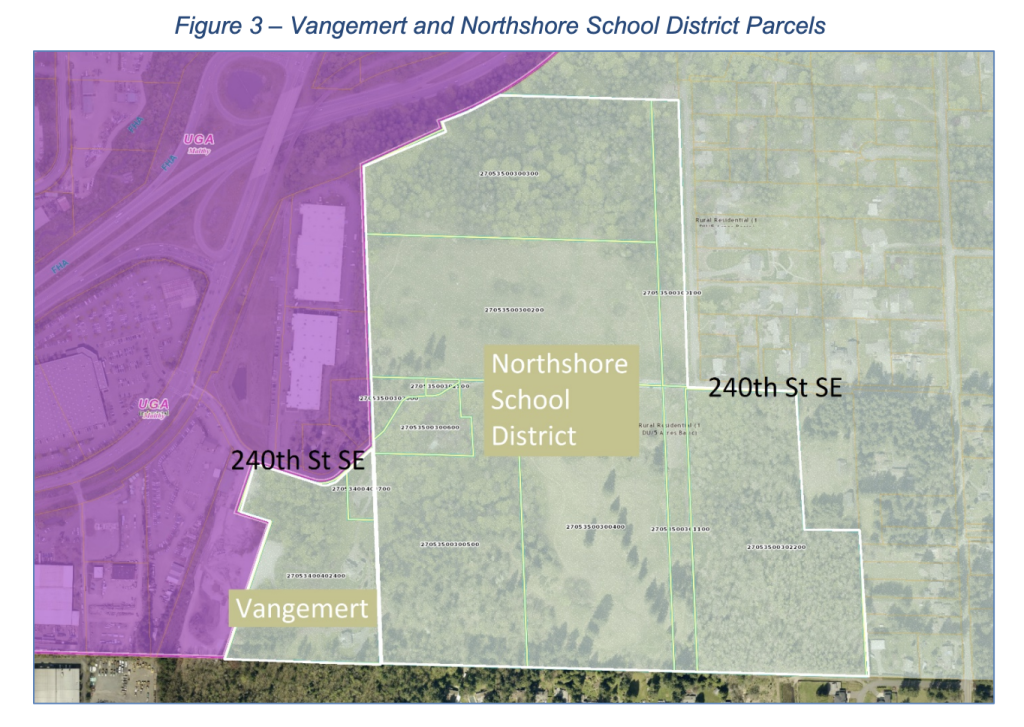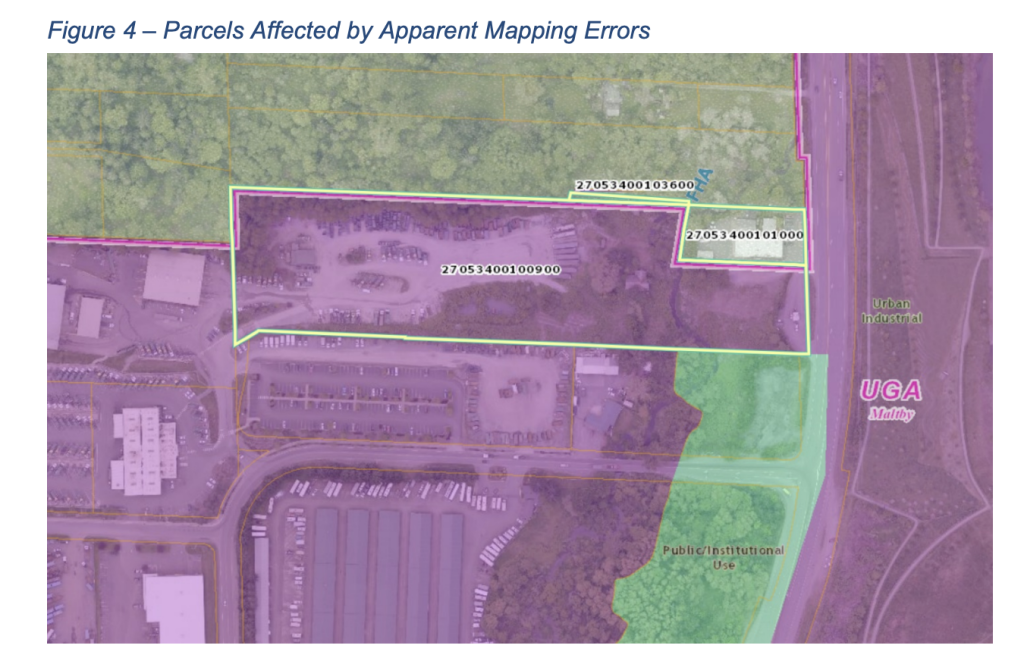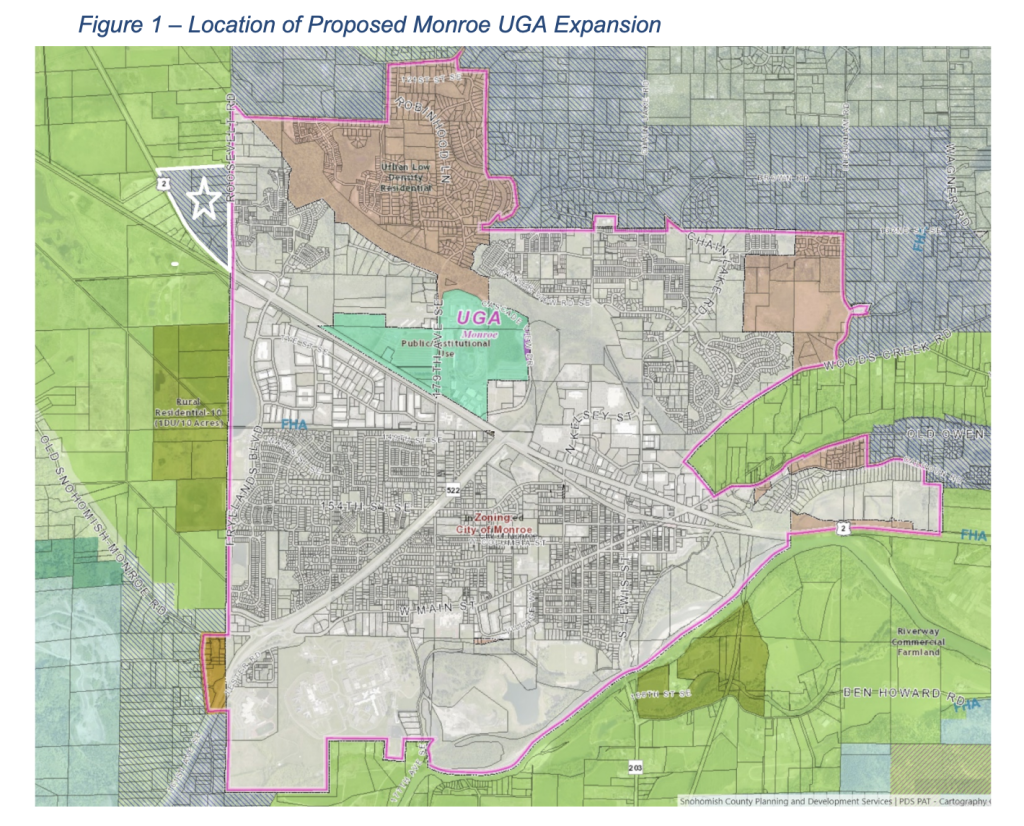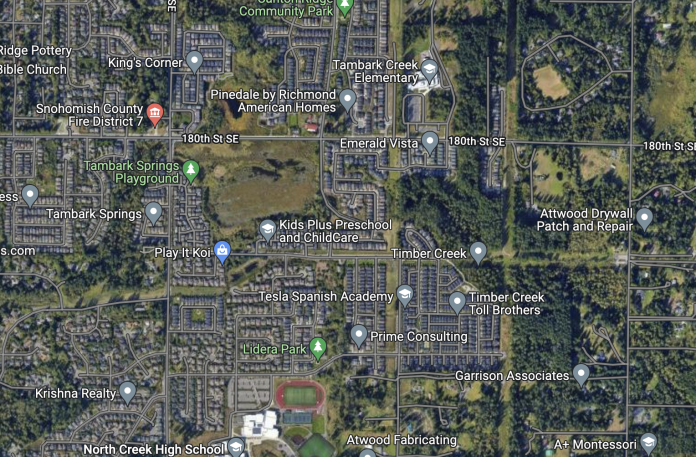
Snohomish County policymakers have advanced proposals that could result in urban growth area (UGA) expansions. In total, 1,283 acres could be added to the county’s UGAs. The proposals are part of the county’s mandated 2024 comprehensive plan update. This comes on the heels of countywide growth targets adopted in the fall that allocated an additional 86,498 residents in urban unincorporated areas with over 97% of those in the Southwest Urban Growth Area by 2044.
Some of the proposals would designate expanded UGA lands for medium density residential zoning and modest urban commercial zoning. However, there are proposals that would also designate expanded UGA lands for low density residential zoning, too.
Snohomish County has a real chance to avoid most any UGA expansions by simply redesignating lower density existing UGA lands to medium and higher density lands for residential development. In fact, the county could establish policies for low, medium, and high density residential lands to accommodate much higher densities than they do today. By and large, existing urban zoning in unincorporated areas is very low density and has the potential for much higher levels of infill housing and redevelopment if policymakers would further reform zoning.
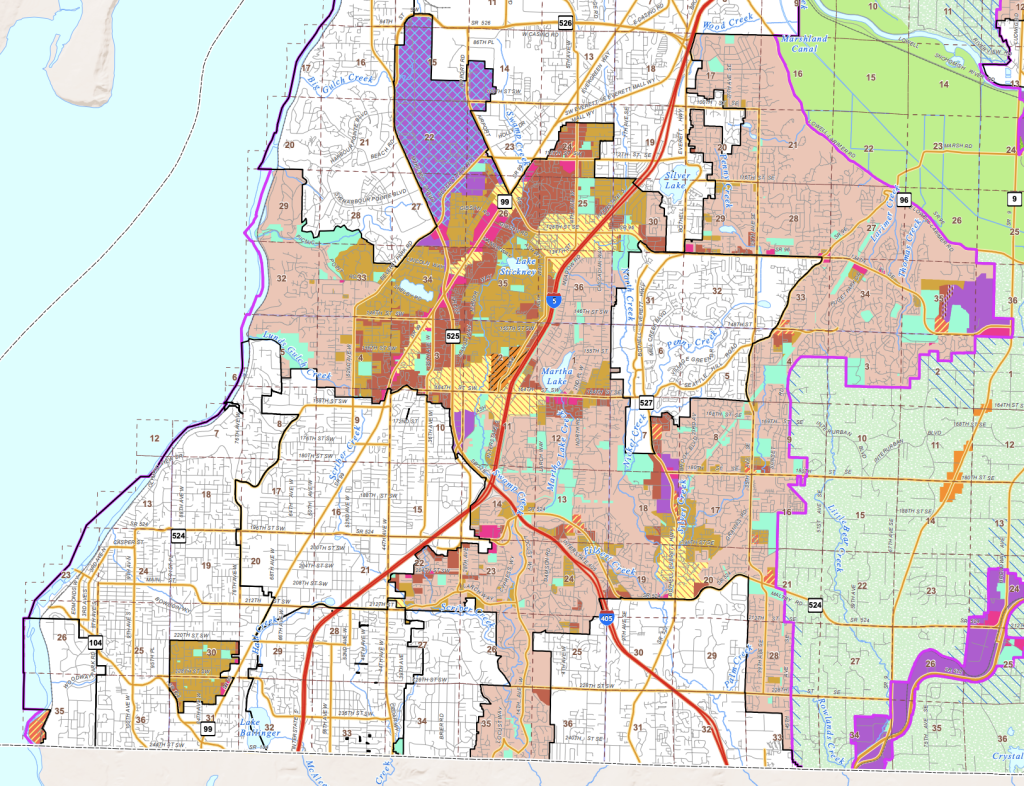
Last year, the county changed its zoning regime for accessory dwelling units. Now urban lots allow up to two accessory dwelling units. In May, the county took more substantial steps in allowing more urban infill housing by modestly adjusting height limits and density bonuses. The county also now allows duplexes and townhouses as-of-right on lots zoned R-7,200 and zoned higher. So there is precedent for more flexibility in what can be built in lower density zones. The county could take that further by reducing setbacks, increasing lot coverage maximums, further increasing building heights and allowed densities, and reducing minimum parking mandates.
Some approaches that the county could consider:
- Allow for more custom missing middle housing types (e.g., courtyard apartments, stacked flats, fourplexes, fiveplexes, and sixplexes) across the board;
- Modify policies for Urban Low Density Residential areas to allow for Urban Medium Density Residential-like development potential;
- Modify policies for other residential and commercial land use types and development standards for their implementing zones;
- Redesignate most Urban Low Density Residential areas to Urban Medium Density Residential and implement corresponding rezones; and
- Redesignate most Urban Medium Density Residential areas to Urban High Density Residential and implement corresponding rezones.
All of this is to say, broadly expanding UGAs is not necessarily a forgone conclusion; the unincorporated UGAs are nowhere close to full. Real work remains in existing UGAs before moving beyond them.
With all that in mind, it’s worth evaluating what UGA expansions are proposed, some of which may indeed be sensible given existing circumstances.
Southwest UGA expansion proposals
The largest unincorporated UGA under Snohomish County’s planning jurisdiction is the Southwest Urban Growth Area (SWUGA) that extends from Puget Sound between cities to about Sunset Road and 45th Avenue SE (a big sector does extend Cathcart). A big SWUGA expansion proposal would extend the boundary a few blocks to the east, largely along the same north-south boundary. A total of 789 acres of land are part of the expansion proposal and include four key subareas. The proposal essentially breaks down as follows:
- The Sunset Road Area would be about 215 acres of land. It would bump the SWUGA out about four blocks just east of Sunset Road from slightly north of 156th Street SE to slightly north of 180th Street SE. Most of the land (191 acres) would be designated as Urban Low Density Residential on the Future Land Use Map (FLUM). The remainder of the area would be designated Public/Institutional Use on the FLUM since it is owned by the Everett School District. All of the land would be zoned R-7,200.
- The Timber Creek Open Space Area would be about 51 acres of land. It would bump the SWUGA out two to three blocks east of the existing Timber Creek subdivision. The land is set aside as open space for the Timber Creek subdivision. The county’s direction on what to do about this is unclear because the land can’t be developed for residential use. One option could be creation a special FLUM designation for private open space and bringing it into the SWUGA or designating the area as a revised Public/Institutional Use within the SWUGA. Another option is doing nothing.
- The 43rd Avenue Area would be about 301 acres of land. It would bump the SWUGA out about six blocks to the east around 43rd Avenue SE. Approximately 30 acres of land could be designated Urban High Density Residential while 241 acres of land could be designated Urban Medium Density Residential or Urban Low Density Residential on the FLUM. Implementing zoning ranges from High Density Multiple Residential to R-7,200 depending upon FLUM designation. Another 30 acres of land could be designated as Public/Institutional Use on the FLUM with R-9,600 zoning for the Northshore School District which has an existing school and plans to add another one.
- The 45th Avenue Area would be about 220 acres of land. It would bump the SWUGA about two blocks east of 45th Avenue SE. Most of the land (185 acres) would be designated as Urban Low Density Residential on the FLUM while the remaining land would be designated as Public/Institutional Use for utilities (e.g., powerlines and pipelines), public park, and fire station. All of the area would be zoned R-7,200.
A related proposal, 43rd Avenue Standalone, for the area contemplates an UGA expansion north of Maltby Road centered on 43rd Avenue SE. It covers 301 acres of land that would largely push the UGA eastward to 46th Avenue SE between Maltby Road and 188th Street SE. That would be about a six-block eastward expansion. Most of the land (271 acres) would be designated Urban Medium Density Residential on the FLUM, which would allow for Low Density Multiple Residential zoning. The remaining 30 acres of land would be designated as Public/Institutional Use with R-9,600 zoning for a Northshore School District site.
Lake Stevens UGA expansion proposals
In the Lake Stevens area, the county has a UGA expansion proposal that would add 302 acres of land in three areas. These include:
- The Sunnyside Boulevard Area would be about 201 acres of land. It would bump out the Lake Stevens UGA several blocks to the west, but outside of the farmland areas. The area would be designated as Urban Low Density Residential on the FLUM with R-7,200 zoning. A small reason for the UGA expansion is to bring in non-conforming R-7,200-level development that vested and developed in the early 2000s. The remainder, however, is purely discretionary UGA expansion for low-density sprawl.
- The SR 9 Area would be about five acres of land. It would bump out the Lake Stevens UGA about four blocks south. The area is currently zoned for rural commercial uses. The proposed changes would redesignate the land to Urban Commercial on the FLUM and zone the land as Community Business.
- The Lake Stevens Landfill Area would be about 86 acres of land. It would bump out the Lake Stevens UGA several blocks in the eastern portion of the UGA. A mix of designations would be made, including Urban Low Density Residential and Public/Institutional Use on the FLUM. The area could be annexed by Lake Stevens with some of the land continuing to be for public use, but privately-owned lots could be redeveloped for low-density residential uses.
Maltby UGA expansion proposals
In the Maltby area, there is one UGA expansion proposal that covers several subareas. This expansion would add about 255 acres of land to the UGA as follows:
- The SR 9/Maltby Road Area would be about 142 acres of land. The area currently consists of some rural commercial uses and a large amount of public uses. As proposed, the area would be designated a mix of Urban Commercial (17 acres), Public/Institutional Use (114 acres), and Urban Industrial (11 acres) on the FLUM.
- The Vangemert and Northshore School District Properties Area would be about 112 acres of land. The Vangemert property (about 12 acres) is an industrial use and would be reflected as such with an Urban Industrial designation on the FLUM and Light Industrial zoning. Northshore School District owns property (about 100 acres) just outside the UGA south of SR 522, which would be redesignated to Public/Institutional Use with R-9,600 zoning.
- A small sliver of land — about 0.87 acres — near the Brightwater Treatment Plant would be redesignated to Urban Industrial on the FLUM with Light Industrial zoning. This would correct a long-standing mapping error.
Monroe UGA expansion proposal
In the Monroe area, there is one UGA expansion proposed near the northwest portion of the city along SR 2. It would add about 68 acres of land with an Urban Low Density Residential designation on the FLUM and be zoned R-7,200.
Summing it up
As previously discussed, the county has immense latitude to continue the policy of urban infill, as encouraged by the Growth Management Act. There is no pressing reason to expand UGAs in the county beyond minor mapping corrections, non-school public facilities, and orphaned commercial areas. All areas of existing UGAs have plenty of land ripe for urban infill development and redevelopment, if zoning and development standards are adjusted. UGA expansions have the consequence of delaying such urban infill and can stretch the limits of public services and resources.
If Snohomish County takes this comprehensive plan update as an opportunity to redirect urban growth to existing urban areas, it could save the county and local governments significant sums of money that can be put back into existing urban communities and serve new residents alike. That’s a win-win.
For example, Northshore School District is in a race to expand new sprawling school sites for sprawling communities. But existing schools could be reinvested in and expanded if the school district didn’t have to chase new families. That could wind up saving the school district and taxpayers a lot of money (e.g., land costs, utility extensions, new playfields, and bus service) that while benefiting existing students, too. The county could help in this regard by loosening up school development regulations, which look like something right out of the 1950s.
As another example, the county won’t have to keep chasing new development with new, ever larger and more complicated roads. Instead, it can focus on improving existing ones to be more efficient with facilities for people to walk, roll, bike, and take transit. But it’s easy to point to plenty of other public services that would cost less to maintain and improve with a focus around urban infill, such as parks, water and sewer utilities, emergency services, and libraries.
In short, county policymakers would be wise to pass on most of the UGA expansions, including those proposed by school districts, and focus on a principal policy of urban infill by redesignating most of the UGA for higher intensity land uses and zones. If county policymakers choose to expand UGAs, those expansions should maximally increase future land use designations and zoning intensity to guard against future discretionary UGA expansions. It’s the equitable and sustainable thing to do.
Stephen is a professional urban planner in Puget Sound with a passion for sustainable, livable, and diverse cities. He is especially interested in how policies, regulations, and programs can promote positive outcomes for communities. With stints in great cities like Bellingham and Cork, Stephen currently lives in Seattle. He primarily covers land use and transportation issues and has been with The Urbanist since 2014.

